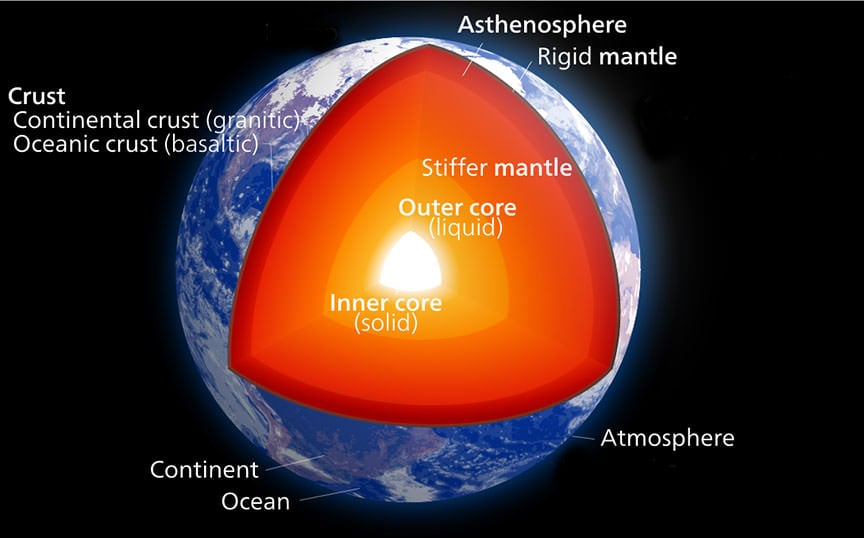Scientists theorize that within Earth's interior, conditions are extremely hot and extremely pressurized. This is what allows for the primarily iron and nickel core to be divided between a solid inner region and liquid outer region. The dynamics of this core are believed to be responsible for driving our planet's protective magnetosphere, which is why scientists are determined to improve their understanding of it.
Thanks to new research conducted by an international team of scientists, it appears that the core region also gets its fair share of "snow"! To put it another way, their research showed that within the outer core, tiny particles of iron solidify and fall to form piles up to 320 km (200 mi) thick on top of the outer core. These findings could vastly improve our understanding of the forces that affect the entire planet.
The research was conducted by a team of researchers from the Jackson School of Geosciences at the University of Texas at Austin who were led by Prof. Youjun Zhang of Sichuan University's Institute of Atomic and Molecular Physics. The study that describes their research was published in the Dec. 23rd issue of the Journal of Geophysical Research (JGR) Solid Earth.
Studying the depths of Earth is no easy task since ground-penetrating radar can't possible probe that deep and direct sampling is absolutely impossible. As a result, researchers are forced to study Earth's interior through the science of seismology - i.e. the study of sound waves that are generated by geological activity and pass through the planet regularly.
By measuring and analyzing these waves, geological scientists are able to get a better picture of the interior's structure and composition. In recent years, they have noted a discrepancy between the seismic data and current models of the Earth's core. Essentially, the measured waves would move slower than expected when passing through the base of the outer core and faster when moving through the eastern hemisphere of the inner core.
To resolve this mystery, Prof. Zhang and his colleagues proposed that crystallization of iron particles could be occurring in the outer core, creating a "snow-capped" inner core. The theory that a slurry layer exists between the inner and outer core was first proposed by S.I. Braginskii in 1963, but was rejected because of the prevailing knowledge of heat and pressure conditions in the core.
However, using a series of experiments conducted on core-like materials and more recent scientific studies, Prof. Zhang and his team were able to show that crystallization in the outer core is indeed possible. Furthermore, they found that about 15% of the lowermost part of the outer core could be made of iron-based crystals that will eventually fall and settle on top of the solid inner core.
"It's sort of a bizarre thing to think about," said Nick Dygert, an assistant professor at the University of Tenessee who helped conduct the research as part of a postdoctoral fellowship with the JSG. "You have crystals within the outer core snowing down onto the inner core over a distance of several hundred kilometers."
As Prof. Jung-Fu Lin (another co-author on the study) explained, this is similar to how rocks form inside volcanoes. "The Earth's metallic core works like a magma chamber that we know better of in the crust," he said. The team even compared the process hat causes piles of iron particles to form on the Earth's outer core to what happens inside magma chambers closer to Earth's surface.
Whereas the compacting of minerals creates what's known as "cumulate rock" in magma chambers, the compaction of iron particles deep in Earth's interior contributes to the growth of the inner core and shrinking of the outer core. The accumulation of these particles against the outer core would account for the seismic aberrations since a variation in thickness between the eastern and western hemispheres would explain the change in speed.
Given the core's influence over planet-wide phenomena - like the aforementioned magnetosphere and the heating that drives tectonic activity - learning more about its composition and behavior is essential to improving our understanding of how these larger processes work. In this respect, the research conducted by Prof. Zhang and his colleagues could help resolve long-standing questions about Earths' interior and how it came to be.
As Bruce Buffet, a geosciences professor at the UC Berkley who studies planetary interiors (and was not involved in the study) put it:
“Relating the model predictions to the anomalous observations allows us to draw inferences about the possible compositions of the liquid core and maybe connect this information to the conditions that prevailed at the time the planet was formed. The starting condition is an important factor in Earth becoming the planet we know.”
Given the way that Earth's magnetosphere and its tectonic activity are believed to have played a vital role in the emergence and evolution of life, understanding the dynamics of our planet's interior could also assist in the hunt for potentially-habitable exoplanets - not to mention extra-terrestrial life!
The research was funded by the National Natural Science Foundation of China, Fundamental Research Funds for the Central Universities, the Jackson School of Geosciences, the National Science Foundation and the Sloan Foundation.
Further Reading: University of Texas*, JGR Solid Earth*
 Universe Today
Universe Today



